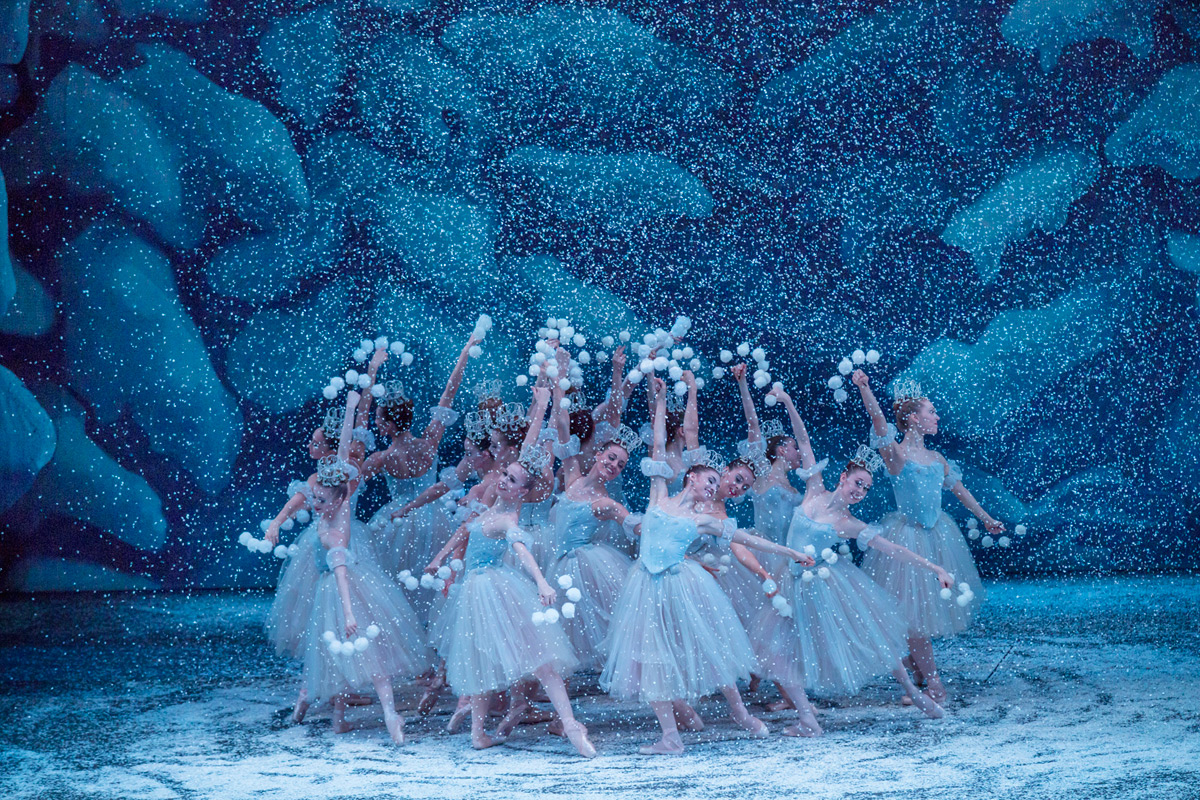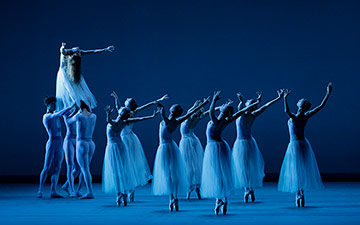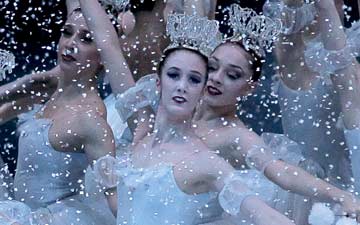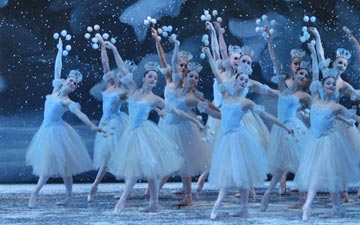
© Paul Kolnik. (Click image for larger version)
New York City Ballet
The Nutcracker
New York, David H. Koch Theater
8 December 2015
www.nycballet.com
Let it Snow
Like Christmas carols, Tchaikovsky’s Nutcracker accosts us at every turn this time of year – at the supermarket, in car commercials, on the radio. It’s easy to forget how beautifully-constructed the score really is, how inexorably it flows, how effectively it tells the story. It manages to encompass a vast range of emotions: excitement, contentment, transformation, anxiety, and, perhaps most surprisingly, grandeur and drama. It has been described as a “symphony of childhood”; it is that, and more.
To really work, a production of the ballet must touch upon all these emotions without overplaying any of them. George Balanchine’s version for New York City Ballet, still going strong after six decades, seems to capture the spirit of the music at every turn. This, even though the choreographer fiddled with the order of the pieces in the second act and added music from another ballet (Sleeping Beauty) in the first. Because The Nutcracker was in his blood – he had performed in it as a young man in St. Petersburg – he could take certain liberties.
There are darker, more psychological stagings of The Nutcracker and lighter ones, and versions that are packed with more dancing, but few that have such a sense of proportion. The first act contains mostly social interaction, parlour dances, and straightforward storytelling, and yet it doesn’t drag. In fact, like the first act of Giselle, it is the heart of the ballet. The second is essentially made up of pure dance – with the exception of an extended mime sequence for the Nutcracker prince, a nod to the nineteenth century. Both acts contain moments of low-tech stage magic that still manage to produce a sense of surprise and delight: the monstrous growth of the tree, the transformation of the Nutcracker into a miniature prince in pink breeches, the invisible platform upon which the Sugarplum Fairy glides en pointe, as if skating across a frozen lake.

© Paul Kolnik. (Click image for larger version)
New York City Ballet is well into its month-long Nutcracker marathon. By now, the production is a fine-tuned machine. During the single intermission, one of the younger corps-members stands out on the promenade, in full snowflake regalia, waiting to be photographed with audience-members. That, too, has become part of the show. Onstage, the children, all of them from the School of American Ballet, are impeccable, even, at times, too polished. At the performance I caught (on Dec. 8), they had a tendency to react to things before they happened. One exception was the boy playing Fritz, Marie’s bratty little brother, Sawyer Reo – a real scamp. And Emil José Kelso, the Nutcracker, whose calm demeanor made him a model of good manners and princely bearing. A highlight was the dance for the toy soldier who pops out of a giant gift box. Devon Alberda danced with razor-sharp timing, a little pause preceding each drop to the knee.
The second act contains most of the dancing, prettily packaged into a sequence of international divertissements. The “Coffee” solo, set to a Georgian lullaby and performed in a midriff-baring harem outfit – très exotique – was performed with an ironic wink by Savannah Lowery, which is just as well. (Fresh from her experience dancing for Twyla Tharp, she was in fine form.) Georgina Pazcoguin and Taylor Stanley gave a saucy rendition of the Spanish dance, full of deep back-curves, piquant footwork, and audible finger-snaps.

© Paul Kolnik. (Click image for larger version)
And then came the fireworks. The dainty pointework of the Marzipan Shepherdesses, with their prim, flower-bedecked tutus; the speed and dynamism of the Waltz of the Flowers; the high drama of the final pas de deux. Sterling Hyltin, in particular, danced the stirring Dewdrop solo as if propelled by a strong breeze. Balanchine imagines Dewdrop as a kind of water nymph, swimming through the air, carried along by the music. Hyltin’s jumps spring up into the air with a staccato thrust; her hops on pointe are sharp and light; her shoulders ripple with the music. After this heady crescendo, the pas de deux, danced by Megan Fairchild and Adrian Danchig-Waring, felt a little safe, a little square. Fairchild is much more suited to the sparkling Sugarplum solo that opens the second act; her softness and glow, buoyant jump and well-placed turns do it justice. But the final duet crosses over into epic territory, and works best with a ballerina who can do the same.

© Paul Kolnik. (Click image for larger version)
But Balanchine’s Nutcracker doesn’t live or die by its Sugarplum Fairy. It’s an ensemble piece – another of its charms. Built to last.


















You must be logged in to post a comment.